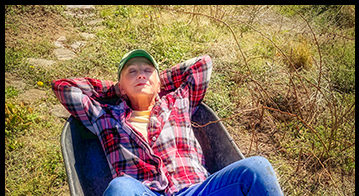By Lavinia Plonka, GCFP CM
I did it again. You’d think at my age, after gardening for most of my adult life, as an experienced Feldenkrais® practitioner, I’d know better. But the lure of the dirt is not based on logic. Its siren call seduces me to claw, dig, pitch, rake, hoe, bringing me literally to my knees as I wrestle invasive black walnut roots, rescue strawberry plants choking in the creeping charlie, and yank stubborn yellow dock from my patch of heaven. One voice congratulates me, “Look at what you’ve accomplished! And what a great workout!”” while another voice says, “You should be taking a break.” And later, “I said you should take a break.” Later still, streaked in sweat and mud, I pull on an invasive raspberry sucker. There’s no question I’m tired, but dammit, I’m not letting this sucker go (pun intended). When it breaks, I fly backwards, literally landing in my wheelbarrow, which obligingly tips over. My husband has a saying, “You never know when you’ve had enough until you’ve had too much.”
When I talk to other gardeners, they confess this same character trait. And like me, they pay the price the next day. Aching back, sore hips and shoulders, not to mention the bump on the head from falling backwards, are par for the course. Let’s face it, it’s impossible to stop having fun in the dirt on a beautiful spring day. So what can you do to recover? And how can Feldenkrais principles help you sustain your energy so you can work even longer?
You’ve read all the articles about proper body mechanics: squat, don’t bend (although my immigrant grandmother weeded till the end by bending at the waist and never ended up at the chiropractor). Use your big muscles. But how do you do that? How do you know what you are using? This is what I love about the Feldenkrais Method. You spend time NOT gardening, lying on the floor, learning how to integrate your spine, your shoulders and pelvis in coordinated actions. Then when you go out into the garden, your intelligent nervous system applies the knowledge. People ask me, “What are the best Feldenkrais lessons for garden work?” And my answer is often, “All of them!”
I was recently teaching a class that explored mobility of the pelvis. After class, one of my students commented, “I spent all weekend in the garden and felt so stiff, I was afraid to bend. After this lesson, I feel I can go back out and do a couple more hours!” Many times, people who were ready to give up their gardens found that by integrating some Awareness Through Movement lessons into their week, their difficulties were diminished and allowed them to continue with pleasure.
In Feldenkrais classes, we take lots of rests. There’s nothing to accomplish. You can go slowly, pause before you are tired, take a moment to integrate and re-organize. But there’s something about the vision of fresh vegetables and colorful flowers, and the imperative to “get it done” that hijacks my intelligence. So what helps me is to have self-care tools when I’ve overdone it. The beauty of Awareness Through Movement® lessons is that you can still do them when everything is aching. And they help re-organize my so that I can go right back out there the next day for more.
Here are a couple of my “go to” lessons, some longer, some shorter, that can sustain your gardening passion (at least till harvest time!) Enjoy. And watch out for that wheelbarrow!
This 10-minute mini-lesson will help relieve the tightness in the lower back for better squatting.
Need to relax your whole spine? This 25-minute version will help you re-boot back and hips.
When everything is super tight, give yourself a hug. Bonus, it feels like you’re not just hugging yourself, but rocking and rolling your whole body.
About Lavinia:
 Lavinia Plonka is co-editor of SenseAbility and has been a Feldenkrais teacher for over 30 years. Her website is www.laviniaplonka.com
Lavinia Plonka is co-editor of SenseAbility and has been a Feldenkrais teacher for over 30 years. Her website is www.laviniaplonka.com

